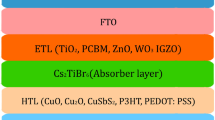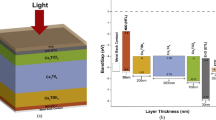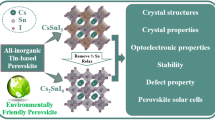Abstract
With lead-based perovskite materials, lead content and long-term stability are the big concerns. Recently, Cesium tin iodide (Cs2SnI6) double perovskite has gained recognition as a stable and environment-friendly photovoltaic material compared to lead-based perovskite materials. In the present study, we have investigated Cs2SnI6 based solar cell with all inorganic transport materials using SCAPS-1D. The optimized device exhibited a maximum efficiency of about 18%. Further we fabricated Cs2SnI6 perovskite films using a solution process approach, utilizing CsI and SnI4 in a 2:1 ratio. For synthesized double perovskite film, the crystallinity, morphologies, and optical characteristics were examined. Additionally, the stability analysis confirmed that the prepared perovskite films were stable for more than two months under ambient exposure. Finally, utilizing the synthesized Cs2SnI6 thin films as an absorber material, we fabricated two solar cells without and with hole transport layer (HTL), having configurations of glass/FTO/ZnO/Cs2SnI6/Ni and glass/FTO/ZnO/Cs2SnI6/ MoS2/Ni, respectively, in the ambient conditions. As a major finding, it has been observed that the inclusion of MoS2 as HTL improved overall performance, with an enhancement in the power conversion efficiency (PCE) of nearly 45% compared to the device without HTL.










Similar content being viewed by others
Data availability
Data sharing is not applicable.
References
R. Wang, M. Mujahid, Y. Duan, Z.-K. Wang, J. Xue, Y. Yang, A review of perovskites solar cell stability. Adv. Func. Mater. (2019). https://doi.org/10.1002/adfm.201808843
National Renewable Energy Laboratory. Best Research-Cell Efficiency Chart (1976 to the present), (2020),https://www.nrel.gov/pv/cell-fficiency.html .
J. Huang, Y. Yuan, Y. Shao, Y. Yan, Understanding the physical properties of hybrid perovskites for photovoltaic applications. Nat. Rev. Mater. (2017). https://doi.org/10.1038/natrevmats.2017.42
P. Wang, Y. Wu, B. Cai, Q. Ma, X. Zheng, W.-H. Zhang, Solution-processable perovskite solar cells toward commercialization: progress and challenges. Adv. Funct. Mater. (2019). https://doi.org/10.1002/adfm.201807661
D. Kumari, S.K. Pandey, Comprehensive study and performance analysis of eco-friendly double perovskite Cs2AgBiBr 6 on Si tandem solar cell. J. Optical. Soc. AmericaB (2022). https://doi.org/10.1364/JOSAB.443938
B. Salhi, Y.S. Wudil, M.K. Hossain, A. Al-Ahmed, F.A. Al- Sulaiman, Review of recent developments and persistent challenges in stability of perovskite solar cells. Renew. Sustain. Ener. Rev. 90, 210–222 (2018). https://doi.org/10.1016/j.rser.2018.03.058
D. Kumari, Saurabh Kumar Pandey, Effect of an ultra-thin 2D transport layer on eco-friendly Perovskite/CIGS tandem solar cell: A numerical study. Micro. Nanostruct. (2022). https://doi.org/10.1016/j.micrna.2022.207398
A. Babayigit, A. Ethirajan, M. Muller, B. Conings, Toxicity of organometal halide perovskite solar cells. NatMater 15(3), 247–251 (2016). https://doi.org/10.1038/nmat4572
Ke. Weijun, M.G. Kanatzidis, Prospects for low-toxicity lead-free perovskite solar cells. Nat. Commun. (2019). https://doi.org/10.1038/s41467-019-8918-3
X. Qiu et al., From unstable CsSnI3 to air-stable Cs2SnI6: A lead-free perovskite solar cell light absorber with bandgap of 1.48eV and high absorption coefficient. Solar Ener. Mater. Solar. Cells (2017). https://doi.org/10.1016/j.solmat.2016.09.022
X. Qiu, Y. Jiang, H. Zhang, Z. Qiu, S. Yuan, P. Wang, B. Cao, Lead-free mesoscopic Cs2SnI6 perovskite solar cells using different nanostructured ZnO nanorods as electron transport layers. Phys. Status. Solidi. RRL 10, 587–591 (2016). https://doi.org/10.1002/pssr.201600166
Y. Jiang, H. Zhang et al., The air and thermal stabilities of lead-free perovskite variant Cs2SnI6 powder. MaterialsLetters (2017). https://doi.org/10.1016/j.matlet.2017.04.046
A. Suazo, F. Josué, S. Shaji, D.A. Avellaneda, J.A. Martínez, B. Krishnan, Solar cell using spray casted Cs2SnI6 perovskite thin films on chemical bath deposited CdS yielding high open circuit voltage”. SolarEnergy (2020). https://doi.org/10.1016/j.solener.2020.06.101
S.T. Umedov, D.B. Khadka, M. Yanagida, A. Grigorieva, Y. Shirai, A-site tailoring in the vacancy-ordered double perovskite semiconductor Cs2SnI6 for photovoltaic application. Sol. Energy Mater. Sol. Cells (2021). https://doi.org/10.1016/j.solmat.2021.111180
W. Zhu, T. Yao, J. Shen, W. Xu et al., In situ investigation of water interaction with lead-free all inorganic perovskite (Cs2SnIxCl6−x)”. J. Phys. Chem. C (2019). https://doi.org/10.1021/acs.jpcc.9b00720
B. Lee, C.C. Stoumpos, N. Zhou et al., Air-stable molecular semiconducting iodosalts for solar cell applications: Cs2SnI6 as a hole conductor. J. Am. Chem. Soc. 136(43), 15379–15385 (2014). https://doi.org/10.1021/ja508464
J. Zhang, S. Li, P. Yang et al., Enhanced stability of lead-free perovskite heterojunction for photovoltaic applications. J MaterSci 53, 4378–4386 (2018). https://doi.org/10.1007/s10853-017-1890-z
G. Kapil, T. Ohta, T. Koyanagi et al., Investigation of interfacial charge transfer in solution processed Cs2SnI6 thin films. J. Phys. Chem. C 121(24), 13092–13100 (2017). https://doi.org/10.1021/acs.jpcc.7b04019
J. C.-R Ke., D. J. Lewis, A. S. Walton, B. F. Spencer, P. O’Brien, A. G. Thomas, & W. R. Flavell, Ambient-air-stable inorganic Cs2SnI6 double perovskite thin films via aerosol-assisted chemical vapour deposition. J. Mater. Chem. A 6(24), 11205–11214 (2018). https://doi.org/10.1039/C8TA03133A
X.D. Wang, Y.H. Huang, J.F. Liao, Y. Jiang et al., In situ construction of a Cs2SnI6 perovskite nanocrystal/SnS2 nanosheet heterojunction with boosted interfacial charge transfer. J. Am. Chem. Soc. (2019). https://doi.org/10.1021/jacs.9b04482
D. Liu, T. Kelly, Perovskite solar cells with a planar heterojunction structure prepared using room-temperature solution processing techniques. Nature Photon 8, 133–138 (2014). https://doi.org/10.1038/nphoton.2013.342
J. Urieta-Mora, I. Garcia-Benito, A. Molina-Ontoria, N. Martin, Hole transporting materials for perovskite solar cells: a chemical approach. Chem Soc Rev. (2018). https://doi.org/10.1039/c8cs00262b
G.W. Kim, H. Choi, M. Kim, J. Lee, S.Y. Son, T. Park, Hole transport materials in conventional structural (n-i-p) perovskite solar cells: from past to the future. Adv Energy Mater (2020). https://doi.org/10.1002/aenm.201903403
Z. Hawash, L.K. Ono, Y.B. Qi, Recent advances in spiro-MeOTAD hole transport material and its applications in organic-inorganic halide perovskite solar cells. Adv. Mater. Interfaces. (2018). https://doi.org/10.1002/admi.201700623
D.Y. Liu, Y. Li, J.Y. Yuan, Q.M. Hong, G.Z. Shi, D.X. Yuan, J. Wei, C.C. Huang, J.X. Tang, M.K. Fung, Improved performance of inverted planar perovskite solar cells with F4-TCNQ doped PEDOT:PSS hole transport layers. J. Mater. Chem. A. (2017). https://doi.org/10.1039/C6TA10212C
Y. Zhang, M. Elawad, Z. Yu, X. Jiang, J. Lai, L. Sun, Enhanced performance of perovskite solar cells with P3HT hole-transporting materials via molecular p-type doping. RSC Adv. (2016). https://doi.org/10.1039/C6RA21775C
Md. Anower Hossain, B.A. Merzougui, F.H. Alharbi, N. Tabet, Electrochemical deposition of bulk MoS2 thin films for photovoltaic applications. Solar Ener. Mater. Solar. Cells. (2018). https://doi.org/10.1016/j.solmat.2018.06.026
Y. Li, Y. Wang, Q. Zuo, B. Li, Y. Li, W. Cai, J. Qing, Y. Li, X. Liu, J. Shi, L. Hou, Improved efficiency of organic solar cell using MoS2 doped poly(3,4-ethylenedioxythiophene) (PEDOT) as hole transport layer. Appl. Surf. Sci. (2022). https://doi.org/10.1016/j.apsusc.2022.153042
D. Wang, N.K. Elumalai, Md.A. Mahmud, H. Yi, M.B. Upama, R.A.L. Chin, G. Conibeer, C. Xu, F. Haque, L. Duan, A. Uddin, MoS2 incorporated hybrid hole transport layer for high performance and stable perovskite solar cells. Synth. Metals. (2018). https://doi.org/10.1016/j.synthmet.2018.10.012
A. Capasso, F. Matteocci, L. Najafi, M. Prato, J. Buha, L. Cinà, V. Pellegrini, A.D. Carlo, F. Bonaccorso, Few-layer MoS2 flakes as active buffer layer for stable perovskite solar cells. Adv. Energy Mater. (2016). https://doi.org/10.1002/aenm.201600920
U. Dasgupta, S. Chatterjee, A.J. Pal, Thin-film formation of 2D MoS2 and its application as a hole-transport layer in planar perovskite solar cells. Solar Energy Mater. Solar Cells 172(2017), 353–360 (2017). https://doi.org/10.1016/j.solmat.2017.08.012
X. Nairui, T. Yehua, Q. Yali, L. Duoduo, W. Ke-Fan, One-step solution synthesis and stability study of inorganic perovskite semiconductor Cs2SnI6. Sol. Energy 204, 429–439 (2020). https://doi.org/10.1016/j.solener.2020.04.079
D. Saikia, J. Bera, A. Betal, S. Sahu, Performance evaluation of an all inorganic CsGeI3 based perovskite solar cell by numerical simulation. Opt. Mater. (2022). https://doi.org/10.1016/j.optmat.2021.111839
Md Dulal Haque, Md Hasan Ali, Md Ferdous Rahman, Abu Zafor Md Touhidul Islam, Numerical analysis for the efficiency enhancement of MoS2 solar cell: A simulation approach by SCAPS-1D. Opt. Mater. (2022). https://doi.org/10.1016/j.optmat.2022.112678
H. Dixit, D. Punetha, S.K. Pandey, Performance investigation of Mott-insulator LaVO3 as a photovoltaic absorber material. J. Electron. Mater. (2019). https://doi.org/10.1007/s11664-019-07581-0
A. Kumar, N. Pandey, D. Punetha, R. Saha, S. Chakrabarti, Enhancement in the structural and optical properties after incorporation of reduced graphene oxide (rGO) nanocomposite in pristine CsSnBr 3 for solar cell application. ACS Appl. Electron. Mater. (2023). https://doi.org/10.1021/acsaelm.3c00224
A. Kumar, N. Pandey, D. Punetha, R. Saha, S. Chakrabarti, Tenability and improvement of the structural, electronic, and optical properties of lead-free CsSnCl3 perovskite by incorporating reduced graphene oxide (rGO) for optoelectronic applications. J. Mater. Chem. C 11(10), 3606–3615 (2023). https://doi.org/10.1039/D2TC04586A
R. Shukla, D. Punetha, R. Kumar, S.K. Pandey, Examining the performance parameters of stable environment friendly perovskite solar cell. Optical. Mater. (2023). https://doi.org/10.1016/j.optmat.2023.114124
S. Ternes, J. Mohacsi, N. Lüdtke, H.M. Pham, M. Arslan, P. Scharfer, W. Schabel, B.S. Richards, U.W. Paetzold, Drying and coating of perovskite thin films: how to control the thin film morphology in scalable dynamic coating systems. ACS Appl. Mater. Interfaces. 14(9), 11300–11312 (2022). https://doi.org/10.1021/acsami.1c22363
R. Shukla, R. Kumar, D. Punetha, S.K. Pandey, Design perspective, fabrication, and performance analysis of formamidinium tin halide perovskite solar cell. IEEE J. Photovoltaics. (2023). https://doi.org/10.1109/JPHOTOV.2023.3241793
P. Subudhi, D. Punetha, Progress, challenges, and perspectives on polymer substrates for emerging flexible solar cells: A holistic panoramic review. Prog. Photovoltaics: Res. Applications. (2023). https://doi.org/10.1002/pip.3703
R. Shukla, S. Pandey, Design, performance, and defect density analysis of efficient eco-friendly perovskite solar cell. IEEE Trans. Electron Devices (2020). https://doi.org/10.1109/TED.2020.2996570
B. Chen, H. Hu, T. Salim, Y.M. Lam, A facile method to evaluate the influence of trap densities on perovskite solar cell performance. J. Mater. Chem. C 7, 5646–5651 (2019). https://doi.org/10.1039/C9TC00816K
M.F. Mohamad Noh, N.A. Arzaee, I.N. Nawas Mumthas, N.A. Mohamed, S.N.F. Mohd Nasir, J. Safaei, A. R. Bin M. Usoff, M. K. Nazeeruddin, and M. A. Mat Teridi, High-humidity processed perovskite solar cells. J. Mater. Chem. A 8, 10481–10518 (2020). https://doi.org/10.1039/d0ta01178a
Acknowledgements
The authors express their deep gratitude to the Chemistry, Physics, and Mechanical departments of IIT Patna for accessing their resources for the characterization of prepared samples. The authors also express their gratitude to Prof. Marc Burgelman from the University of Ghent, Ghent, Belgium, for providing SCAPS-1D software to carry out research.
Author information
Authors and Affiliations
Contributions
Dolly Kumari: conception, methodology, simulation analysis, manuscript writing Nilesh Jaiswal: conception, methodology, formal analysis, manuscript writing Ragvendra Shukla: methodology, result analysis, proofreading Deepak Punetha: methodology, result analysis, proofreading Sushil Kumar Pandey: Continous supervision and proofreading Saurabh Kumar Pandey: Continous supervision and proofreading.
Corresponding author
Ethics declarations
Competing interest
The authors claim that they have no known conflicts of interest that would have affected the research findings in this study.
Additional information
Publisher's Note
Springer Nature remains neutral with regard to jurisdictional claims in published maps and institutional affiliations.
Rights and permissions
Springer Nature or its licensor (e.g. a society or other partner) holds exclusive rights to this article under a publishing agreement with the author(s) or other rightsholder(s); author self-archiving of the accepted manuscript version of this article is solely governed by the terms of such publishing agreement and applicable law.
About this article
Cite this article
Kumari, D., Jaiswal, N., Shukla, R. et al. Design and fabrication of all-inorganic transport materials-based Cs2SnI6 perovskite solar cells. J Mater Sci: Mater Electron 34, 1792 (2023). https://doi.org/10.1007/s10854-023-11197-w
Received:
Accepted:
Published:
DOI: https://doi.org/10.1007/s10854-023-11197-w




